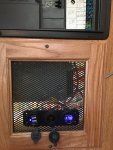Buddha.
Finally in expo white.
I then let the truck have a rest and gave the Progressive Dynamics converter a test. It's the 60 amp model with "charge wizard" (smart multi stage charger).
Notice the difference between the voltages at the charger and at the battery 25' away. From the factory the charge wire from the converter is 6awg. There is no dedicated negative lead between the converter and batteries, it uses the frame as it's negative lead.


Notice the difference between the voltages at the charger and at the battery 25' away. From the factory the charge wire from the converter is 6awg. There is no dedicated negative lead between the converter and batteries, it uses the frame as it's negative lead.


Last edited:



